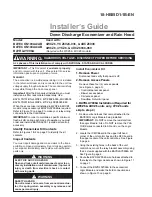
Air-tightness Test on the Refrigerant System
Before system charged with refrigerant and before the refrigerating system in put into operation, below site test
procedure and acceptance criteria shall be verified by the certified technicians, and/or the installer:-
Step 1: Pressure test for refrigerant leak detection:
1 Steps for pressure test, in accordance to ISO 5149.
2 Evacuate the system from refrigerant before the leak test, attach the gauge manifold set correctly and tightly.
Charging hose of Low side connect to Gas side. (Charging hose of High side connect to Liquid side if
applicable.)
3 Adjust the knob on the service valves, and regulator on the gauge set, so that test gas can be inserted
through the centre manifold of the gauge set.
4 Insert Nitrogen gas into the system through the centre manifold and wait until the pressure within the system
to reach about 1MPa (10 BarG) wait for a few hours and monitor the pressure reading on the gauges.
5 Please note that the system’s pressure may rise slightly if the test is carried out on mid day, due to
temperature rise. The inverse may happen when there is temperature drop at night. However, this variation
will be minimal.
6 Waiting time depends on the size of the system. Larger systems may require 12 hours of waiting time. Leak
detection within smaller system can be achieved in 4 hours.
7 Check if there is a constant pressure drop. Move to next step “Step 2: Refrigerant leak detection...” if there is
any pressure drop. Otherwise, release the Nitrogen gas and, move to “Step 3: Vacuum test”.
8 Next, insert a small amount of same refrigerant into the system through the centre hose, until the pressure
reaches about 1MPa (10 BarG).
Step 2: Refrigerant leak detection through Electronic halogen leak detector and/or ultrasonic leak detector:
1 Use any one of below detector to check leaking.
o
Electronic halogen leak detector.
Switch on the unit.
Cover the test area from direct draft.
Pass the detection probe near test area and wait for audible and visible signals.
o
Ultrasonic Leak Detector
Make sure the area is quiet.
Switch on the ultrasonic leak detector.
Move the probe along your air conditioning system to test for leaks, and mark for repair.
2 Any leak detected at this level shall be repaired and retested, starting from “Step 1: Pressure test”.
NOTE:
Always recover the refrigerant and Nitrogen gas into recovery cylinder after completion of a test.
You must use the detection equipment with Detectable Leak Rate of 10
-6
Pa.m
3
/s or better.
Do not use refrigerant as test medium for system with total refrigerant charge more than 5kg.
Test shall be performed with dry Nitrogen or another non-flammable, non-reactive, dried gas. Oxygen, air or
mixtures containing them shall not be used.
Step 3: Vacuum test:
1 Perform Vacuum test to check leak / moisture if present.
2 Refer to section “EVACUATION OF THE EQUIPMENT” to vacuum gas out of the air conditioning system.
3 Wait for a few hours, depending on the size of the refrigerating system and monitor the pressure rise. If the
pressure rises until 1 bar absolute, then there is leak. If the pressure rises, but it is lower than 1 bar absolute,
then moisture is present.
7
2
4
8
2
3
N
2
R -###
(Low/Gas)
pressure gauge
(High/Liquid) pressure gauge
An example illustrations of setup for
refrigerant leak detection.
















































